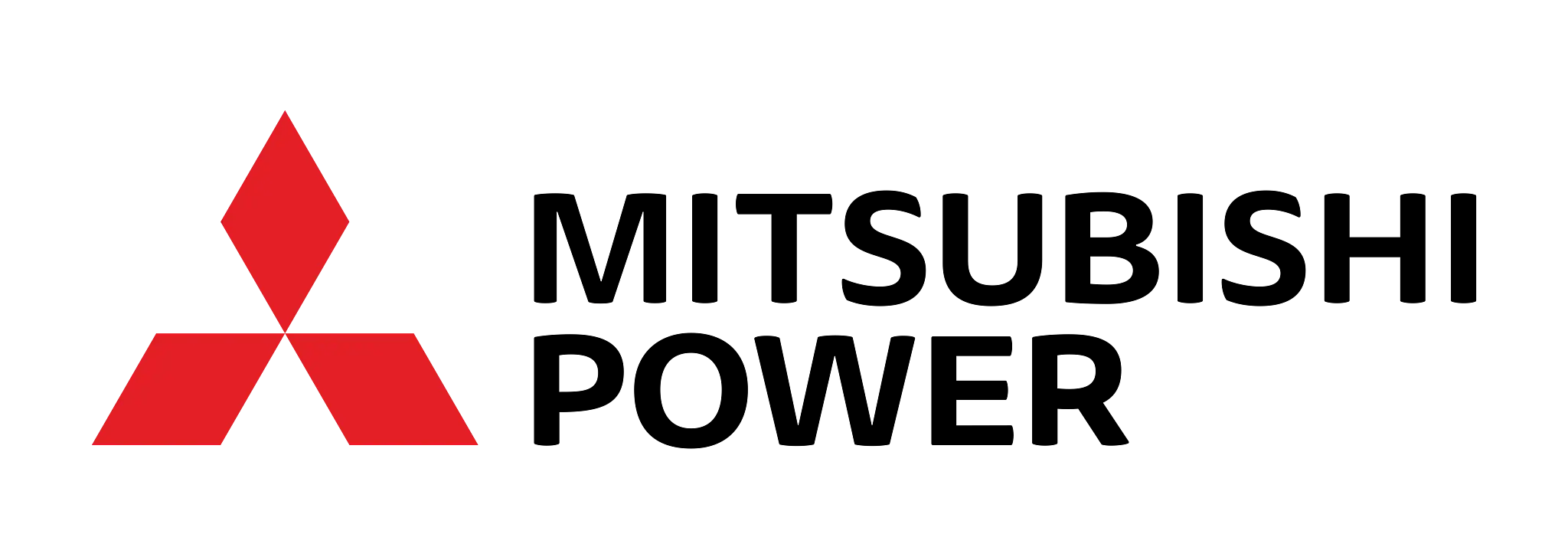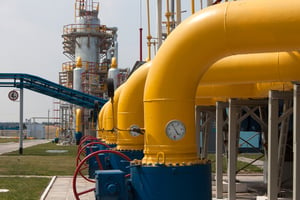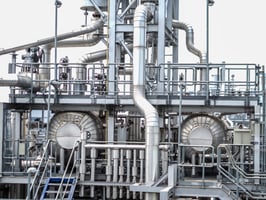
Capabilities
Design, analyze, and optimize complex gas piping systems with precise compressible flow modeling.




Overview
Solve mass, momentum, energy, state, and Mach number simultaneously to analyze real gas behavior, heat transfer, sonic choking, and complex gas networks effectively.
Support open or closed networks with compressors, control valves, heat exchangers, fans, multiple gases, elevation changes, and fluid mixtures.
Enhance analysis with optional modules like Goal Seek & Control for multivariable optimization, Extended Time Simulation for dynamic behavior, and Automated Network Sizing for cost-efficient design.
Import from formats like CAESAR II, EPANET, GIS, and PCF, export to Excel, and run or compare multiple design scenarios within a single model for streamlined evaluation.
Modeling features
Compressors
- Multiple compressor types: Supports modeling centrifugal compressors, positive displacement compressors, and fans, each with behavior tailored to their operational characteristics.
- Manufacturer-driven input: Uses performance curves or maps from supplier or test data to define compressor behavior accurately.
- Compressor maps for full-range performance: Handles multiple speed curves—such as surge and stall limits—and interpolates between them based on rated speed.
- Fixed-flow positive displacement modeling: Represents reciprocating compressors by specifying a constant flow rate while calculating the necessary pressure rise.
- Thermodynamic impact modeling: Accounts for heat of compression using appropriate thermodynamic processes, including temperature changes across the compressor.
- Variable-speed and controlled operation: Allows compressor speed adjustments or dynamic control logic to meet setpoints for flow or pressure.
- Sizing support: Offers built-in tools to size compressors based on required flow and pressure conditions, aiding component selection.
- Library and reuse capabilities: Frequently used compressor configurations can be saved in component libraries for quick reuse in other models.

Pipes
- Complete flow physics: Models compressible, one-dimensional gas flow in pipes, applying mass, momentum, energy, state, and Mach number equations for accurate simulation.
- Friction and pressure loss control: Lets you define friction via material-based roughness, use standard models like Weymouth or Panhandle, or input custom friction factors for precision.
- Built-in fittings and losses: Incorporates elbows, valves, and junction pressure drops directly into pipe definitions, reducing model complexity while capturing realistic behavior.
- Heat transfer flexibility: Supports isothermal, adiabatic, constant heat flux, constant heat rate, and convective heat transfer—complete with optional insulation layers for detailed thermal effects.
- Zero-length connectors: Enables linking components without additional pipe length or loss by designating connections as lossless, streamlining schematic clarity.
- Visual data in context: Displays results (e.g., pressure, temperature, flow) directly on pipes, with color mapping to highlight parameter variations across the network.
- Robust solution engine: Utilizes a high-accuracy marching algorithm with Newton–Raphson iteration and optimized matrix methods to handle complex piping geometries efficiently.
- Library reuse and consistency: Offers built-in pipe libraries (with editable properties), allowing you to create reusable templates and maintain uniform modeling practices.

Valves
- Steady-state resistance options: Handles valve resistance using Cv, Kv, or K-factor loss models to capture pressure drop characteristics under normal operating conditions.
- Component-based loss placement: Represents valve losses at dedicated junctions, improving accuracy by reflecting location-based pressure drop along the pipeline.
- Dynamic behavior through event simulation: Allows valve positions to change over time or triggered by system events (e.g. time-based closure), enabling transient response analysis with the XTS add-on module.
- Configurable control data: Supports interactive tuning of valve performance via loss tables, including insertion of custom flow vs. pressure relationships.
- Simplified modeling for minor losses: Integrates valve-like resistance directly into pipe definitions when detailed valve modeling isn’t needed, reducing clutter while maintaining functionality.
- Interoperability with control logic: Works seamlessly with control components and add-ons (e.g. Goal Seek & Control), allowing valve setpoints to be varied or tuned in conjunction with system goals.
- Graphical linkage to model layout: Valve behavior and output are visualized directly within the flow schematic, aiding intuitive understanding of performance impact.
- Reusable valve templates: Enables saving and reusing valve configurations via component libraries, promoting consistency across projects.

Flow properties
- Full-field compressible flow solution: Simultaneously solves mass, momentum, energy, state, and Mach number equations throughout the pipe network using a robust numerical solver.
- Segmented marching method: Divides pipes into small segments and dynamically marches along the flow path, adapting segment placement based on changes in Mach number for higher accuracy.
- Variable friction modeling: Incorporates friction losses using roughness-based models or conventional formulas like Weymouth and Panhandle, with options for custom friction factors.
- Flow-division losses at tee/wye: Applies detailed correlations—including flow split, pipe area ratios, and angles—for accurate loss calculation at junctions.
- Real-gas and thermal behavior: Accounts for non-ideal gas behavior through compressibility factors and handles various heat transfer modes—including isothermal, adiabatic, and convective—to reflect realistic flow changes.
- Sonic choking detection: Automatically switches to sonic-loss calculations when choking occurs, using CdA-based methods instead of standard K-factor losses.
- Assigned flow control: Allows specifying known flow inputs or outputs at junctions, including options for irrecoverable losses or transient profiles.
- Reference pressure management: Ensures network solvability by requiring at least one pressure reference junction (e.g. tank or assigned pressure) when known flows bound a section.

Import/Export capabilities
- Piping layout import wizard: Supports importing from formats like PCF, CAESAR II neutral files, GIS shapefiles, and EPANET, with a guided preview for mapping components before integration.
- EPANET interoperability: Enables seamless import/export of EPANET files to integrate with public-domain hydraulic modeling workflows.
- Cross-product model sharing: Allows models from other Datacor products like Fathom to be opened and converted in Arrow, preserving structure and enabling further compressible flow analysis.
- Excel output management: Provides an Excel Export Manager to map specific values, rows, or tables into chosen cells or sheets for organized result extraction.
- Excel-driven model edits: Permits importing changes from Excel to adjust model input parameters en masse, supporting scenario updates or batch edits.
- Merge functionality: Lets users merge external model files into the current workspace, enabling consolidation of system components or collaborative building.
- Export of model and output data: Offers tools to export model definitions or output tables to delimited files for flexible usage in spreadsheets or reports.

Scenario manager
- Design Iteration Tracking: Safely explore “what-if” conditions, pump failures, or demand changes without losing your base model.
- Hierarchy-Based Scenario Tree: Organize scenarios in a structured tree with inheritance to avoid repetitive data entry and maintain consistency.
- Easy Switching Between Scenarios: Instantly toggle between scenarios for side-by-side analysis, design evaluation, and troubleshooting.
- Multi-Case Modeling in One File: Store unlimited design alternatives, operating conditions, or failure scenarios within a single project.
- Input Inheritance: Share common data across scenarios (e.g., geometry, fluids) while varying only selected inputs—greatly reducing maintenance.
- Scenario Comparison Tool: Highlight differences in input data and output results across multiple cases for clear, data-driven decisions.
- Scenario Export & Reuse: Export individual scenarios or branches for reuse in other models or for team collaboration.
- Batch Run Capability: Run multiple scenarios automatically and review results efficiently, saving time during optimization studies.

Reporting features
Output
- Customizable output tables: Tailor the Output window by selecting which parameters, pipes, and junctions are shown, controlling order and units for clarity.
- Inspection Window result access: Hold right-click on a pipe or junction in the workspace to quickly inspect the input data and output results directly at the model element.
- Flexible export options: Copy results to the clipboard, save as text, PDF, or delimited files, or use the Excel Export Manager to map output into specific spreadsheets.
- Visual summary diagrams: Display compressor/fan summaries, pipe heat transfer visualizations, and axial point data in intuitive diagram form for quick interpretation.
- Multi-scenario comparison: View outputs from multiple operating scenarios in one window, with color-coded differentiation and scenario ordering for easy comparison.
- Design alert reporting: Group warnings, cautions, and design alerts in the General Output section and see counts for each scenario after batch runs.
- Quick object navigation: From output tables, right-click to locate the corresponding object in the workspace—helping bridge results to model structure.
- Advanced parameter output: Include thermodynamic and flow-specific metrics such as compressor RPM, dimensionless heat-transfer numbers, and valve xT values for deeper insight.

Visual results
- Layered visibility control: Use multiple layers, like a stack of transparencies, to show or hide pipes, junctions, labels, annotations, and results directly on the workspace.
- Simultaneous input/output views: Display input data and analysis results together or separately by toggling individual layers—no need to switch windows.
- Custom views with presets: Save and reuse layer visibility configurations as presets, and optionally link them to specific scenarios for automatic switching.
- Color mapping as a layer: Apply color maps on their own layer to highlight parameters (e.g., pressure, flow rate) across the model without altering underlying geometry.
- Live style customization: Adjust properties such as color, line thickness, and label visibility per layer, with changes instantly reflected on the workspace.
- Layer-based label control: Control which objects display input/output values, names, or annotations by managing label visibility across layers.
- Annotation management: Add or hide annotations (like notes or revision markers) on specific layers, keeping the model clean yet informative.
- Prioritized stacking: When objects exist on multiple layers, the top-most layer’s appearance governs what’s visible, allowing layered context and emphasis.

Graph results
- Wide selection of graph types: Generate pump/fan vs. system curves, profile plots along flow paths, and transient graphs (when using the XTS module).
- Custom graph organization: Save graphs into folders, display multiple graphs side by side or in tabs, and re-run them quickly for updated data.
- Multi-scenario overlays: Plot results from different scenarios together in the same graph to compare system behavior under varied conditions.
- Formatting flexibility: Customize axis scales, labels, colors, and styles; stack multiple series or use dual Y-axes for clearer comparisons.
- Data export and cross-plotting: Export graph data to delimited files or Excel, and import previous results to cross-plot for deeper analysis.
- Quick graph creation: Right-click objects or flows in the workspace to generate graphs instantly.
- High-quality sharing option: Copy graphs as images, save directly as picture or PDF files, or send to printer—all from within the graph window.
- Graph templates: Store graph configurations as reusable templates so you can regenerate formatted plots easily across models and scenarios.

Supported codes & standards
ASME
- ASME Steam Tables: Uses the IAPWS Industrial Formulation (1997) for steam property calculations.
- Pipe Material Standards: Provides pipe material properties sourced from standards including ASTM, ANSI, and ASME.
- Gas Relief System Piping Standards: Supports design and analysis under ASME, API, and ISO guidelines for gas relief system piping.

Dust collection
- Dust collection airflow standards: Arrow models gas flow systems, including dust collection ducts, allowing users to confirm that air velocities meet NFPA requirements for safe dust removal—helping prevent accumulation that could become combustible

Hydraulic Institute Standards
- ANSI/ISA-75.01.01-2012 Valve Flow Definitions
- Arrow uses this standard for calculating both Cv and Xt in compressible flow, ensuring valve behavior aligns with recognized industrial specifications.
- ANSI/API 526 Relief Valve Reference
- The software references this ASME/API standard for flanged steel pressure-relief valves to guide accurate modeling of relief valve behavior.
- Hydraulic Institute Involvement and Development
- Datacor participates actively in the Hydraulic Institute’s committees, contributing to standards like the HI 9.6.7 viscosity correction guideline. This collaboration ensures Arrow aligns with broader pump and system design best practices.

API standards
- ANSI/API 526 (7th Edition) — Used for modeling flanged steel pressure-relief valves, ensuring proper sizing and behavior of relief components.

International standards
- DIN & JIS Pipe Materials: Offers pipe material data drawn from international standards including DIN (Germany) and JIS (Japan), in addition to ASTM, ANSI, AWWA, and ASME libraries, for globally relevant specification alignment.
- ISO Gas Relief Piping: Supports compliance with ISO standards for gas relief system design, particularly for cross-border applications alongside ASME and API references.

Other standards
- ASTM Material Standards: Incorporates pipe and material properties consistent with ASTM specifications for dimensions, pressure ratings, and roughness.
- AWWA Pipe Standards: Includes data for waterworks and industrial piping systems that follow AWWA guidelines.
- MSS-SP Valve Standards: Supports valve dimensions, pressure classes, and configurations defined by the Manufacturers Standardization Society.

Add-on Modules
Software extension tools that can help you quickly and efficiently complete projects. Modules can work individually or together.
Identifies input parameters that yield desired output values and simulates control functions. Used with either Fathom or Arrow.
Models dynamic system behavior in steady-state flow and how critical system parameters vary over time. Used with either Fathom or Arrow.
Evaluates the complex interaction of system variables to reveal combinations of cost savings. Used with either Fathom or Arrow.
The Chempak add-on utility provides a thermophysical database of almost 700 liquids and 600 gases with mixing capability.
Discuss your pipe flow modeling software goals with a simulation expert.
The steam pressures recorded were within 5% of the results of the Arrow analysis.”